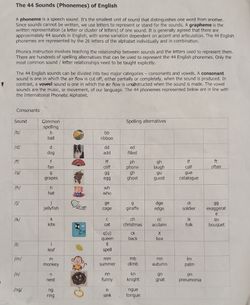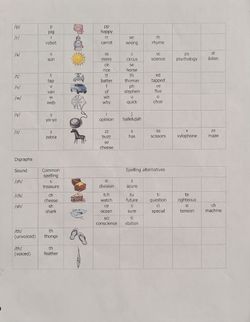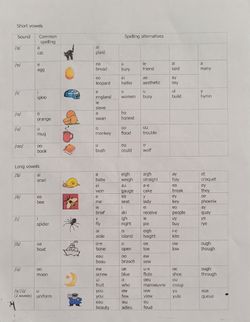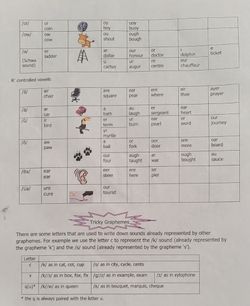Feb 15, 2023
44 sounds of english The consonant sounds




CONSONANTS
The first set of symbols presented here represents consonant sounds. Most are fundamental to English pronunciation regardless of accent. Since you might be unfamiliar with some of the terms used to describe the sounds, here are some definitions you might find useful:
Voiced: a voiced sound is a sound where the vocal cords vibrate, thus producing some sort of pitch. This is the kind of sound most people associate with regular talking or singing.
Voiceless / unvoiced: a voiceless or unvoiced sound is one where the vocal cords do not vibrate, thus making the sound very whispery and without a pitch. It can tend to make a letter sound harsher when pronounced.
Stop: a consonant sound where the airflow is stopped completely by the mouth and then sharply released. Think of sounds like “p,” “k,” and “t.” All languages contain stops.
Fricative: a consonant sound where the airflow becomes noisy and turbulent because it only has a very small space to travel through in the mouth. Think of sounds like “f,” “s,” and “sh.” Most languages have fricatives, but not all.
Nasal: a consonant sound where the airflow passes exclusively through the nose instead of the mouth. Think of sounds like “m,” “n,” or “ng.” Almost all languages have nasals.
Affricate: a consonant sound that begins like a stop but then releases like a fricative, thus making it a sort of combination sound. Think of sounds like “ch” and “j.” Affricates are common, especially in English.
Alveolar ridge: a ridge found on the roof of the mouth between the upper teeth and the hard palate, which is used in conjunction with the tip of the tongue to make many sounds
Soft palate: the soft tissue in the back of the roof of your mouth, which is used In conjunction with the back of the tongue to make many sounds
/P/
Voiceless stop made with both lips
Found in words like: pen, spin, tip, happy
Letters that usually represent it: “p”
/B/
Voiced stop made with both lips
Found in words like: but, web, baby
Letters that usually represent it: “b”
As you may have noticed, the only difference between producing /p/ and /b/ is the voicing, while all other factors remain the same.
It’s common, including in English, to have pairs of words that are essentially the same, except one is voiced and the other is unvoiced. If you’re having trouble pronouncing certain sounds, try to identify a corresponding sound with a different voicing as a reference.
/T/
Voiceless stop made with the tip of the tongue on the alveolar ridge
Found in words like: two, sting
Letters that usually represent it: “t”
/D/
Voiced stop made with the tip of the tongue on the alveolar ridge
Found in words like: do, daddy, odd
Letters that usually represent it: “d”
/K/
Voiceless stop made with the back of the tongue on the soft palate
Found in words like: cat, kill, skin, queen, unique, thick, chaos
Letters that usually represent it: “k,” “c,” “q,” “que,” “ck,” sometimes “ch”
/G/
Voiced stop made with the back of the tongue on the soft palate
Found in words like: go, get, beg, bigger
Letters that usually represent it: “g”
/F/
Voiceless fricative made by putting your upper front teeth on your lower lip
Found in words like: fool, enough, leaf, off, photo, glyph
Letters that usually represent it: “f,” “ph,” sometimes “gh”
/V/
Voiced fricative made by putting your upper front teeth on your lower lip
Found in words like: voice, have, of, over
Letters that usually represent it: “v,” sometimes “f”
/Θ/
Voiceless fricative made by putting your tongue between your teeth
Found in words like: thing, teeth, Athens
Letters that usually represent it: “th”
If you’re curious about this symbol, it comes from the Greek letter “theta,” which makes the same sound in Greek.
/Ð/
Voiced fricative made by putting your tongue between your teeth
Found in words like: this, breathe, father
Letters that usually represent it: “th”
You might have noticed that both /θ/ and /ð/ are represented by “th” in English. Although sometimes there are rules as to when a letter or letter cluster makes different sounds, there really is no rule for “th.”
Sometimes it’s voiced, and sometimes it’s unvoiced, and you’ll just have to memorize the difference as you come across each word with a “th” in it. This letter seems to be based off of the Greek letter “delta,” which makes the same sound in Greek.
/Ʃ/
Voiceless fricative made by putting the tip the tongue a little bit past the alveolar ridge
Found in words like: she, sure, session, emotion, leash
Letters that usually represent it: “sh,” “si,” “ti,” sometimes “s,”
/Ʒ/
Voiced fricative made by putting the tip the tongue a little bit past the alveolar ridge
Found in words like: genre, pleasure, beige, equation, seizure, vision
Letters that usually represent it: “g,” “si,” “ti,” “z,” sometimes “s”
/S/
Voiceless fricative made by putting the tip the tongue nearly on the alveolar ridge
Found in words like: see, city, pass, lesson
Letters that usually represent it: “s,” sometimes “c”
/Z/
Voiced fricative made by putting the tip the tongue nearly on the alveolar ridge
Found in words like: zoo, rose, clothes, asthma
Letters that usually represent it: “z,” sometimes “s,” rarely “th”
/TƩ/
Voiceless affricate made with the tip of the tongue on the alveolar ridge
Found in words like: chair, nature, teach
Letters that usually represent it: “ch,” sometimes “t”
This is one of the two affricates in English, the other being /dʒ/. As stated in the definitions above, an affricate is a combination of a stop and a fricative, so the “ch” sound is actually represented by two IPA symbols. The same goes for the “j” sound.
/DƷ/
Voiced affricate made with the tip of the tongue on the alveolar ridge
Found in words like: gin, joy, edge, did you, judgment
Letters that usually represent it: “j,” sometimes “g,” “dg,” sometimes “d”
/H/
Voiceless fricative made by a forced breath through the glottis
Found in words like: genre, pleasure, beige, equation, seizure, vision
Letters that usually represent it: “g,” “si,” “ti,” “z,” sometimes “s”
/ʔ/
Glottal stop made by shutting and releasing airflow through the glottis
Found in words like: uh–oh, kitten, Manhattan, bet, important (American)
Letters that usually represent it: “t,” “-,” the beginnings of vowels
You might be a little confused by this backwards-question-mark-looking symbol, but the best way to hear and feel it is to say the word “uh-oh.” You’ll feel your vocal cords close for just a moment in order to block your airflow, which is what linguists call a “glottal stop.”
You can also feel this stop happen every time you begin to pronounce a vowel without a consonant before it. The glottal stop is common in some British accents, but it’s especially common in American accents, where the letter “t” is often replaced by this sound in the middle and ends of words. Yes, it’s true.
Most Americans don’t pronounce “kitten” with such a strong, harsh /t/ in the middle, but rather with a /ʔ/ instead.
/M/
Nasal sound formed while the lips are shut
Found in words like: man, them, hammer
Letters that usually represent it: “m”
/N/
Nasal sound formed while the tip of the tongue is on the alveolar ridge
Found in words like: no, tin, winner
Letters that usually represent it: “n”
/Ŋ/
Nasal sound formed while the back of the tongue is on the soft palate
Found in words like: ringer, sing, finger, drink
Letters that usually represent it: “ng,” sometimes part of “ng,” part of “nk”
The letters “ng” can be problematic because the /ŋ/ sound is sometimes followed by a /g/ sound, but sometimes it isn’t. Note the difference between “singer” and “finger,” where “finger” has that extra /g/ sound, but “singer” doesn’t.
This difference is random and should be memorized, just like the “th” phenomenon, but there are a few tricks that can help. For example, if a word ends in “ng,” then there is never a following /g/ sound. There also is no /g/ sound if the word ends in “-ing,” which turns verbs into participles or gerunds.
/ɾ/
A momentary stop-like sound called a flap or tap, caused by the tip of the tongue lightly throwing itself against the alveolar ridge
Found in words like: better, hidden, hater, odor
Letters that usually represent it: “t,” “d”
This is another sound that might confuse you. This is because it’s primarily found in American accents and is essentially another way that Americans become lazy with the letter “t.” You saw previously that the glottal stop is a way to replace the /t/ sound in the middle and ends of words.
However, Americans sometimes use the flap instead in the middle of words, though note that the /ʔ/ and /ɾ/ sounds are mutually exclusive. For example, an American would pronounce the word “button” with a /ʔ/ in the middle, but not a /ɾ/. Meanwhile, “better” is pronounced with a /ɾ/ but not a /ʔ/, at least in an American accent.
/ɾ/ is actually the letter “r” in many other languages like Spanish, Korean, and Arabic (the symbol even looks like some degenerate letter “r”). In terms of sound, consider it to be a softer version of /d/, which is why the letter “d” is often replaced by it, too.
/X/
Voiceless fricative made by putting the back of your tongue nearly on your soft palate
Found in words like: loch (Scottish), ugh
Letters that usually represent it: “gh”
This is an interesting sound because it is not actually a standard sound in English. However, it is easy for most English speakers to make, and occasionally shows up in oddball words like “ugh,” where the /x/ sound is almost an extra marker of exasperation.
So far we have seen sounds that are, for the most part, unmistakably consonants. At this point, you might think we’d move onto vowels. However, there are some sounds that seem to share characteristics of both consonants and vowels.
Already, you have seen the nasals /m/ and /n/, which almost act like vowels but up in the nasal cavity. But in the IPA, there is another class of sounds called “approximants” that lie somewhere between vowels and consonants. Two categories within these approximants are known as “glides” and “liquids.”
Glides are sounds that are phonetically similar to vowels but function more as consonants, while liquids are sounds in which the tongue creates a partial closure in the mouth, resulting in a vowel-like sound.
/L/
Liquid created by keeping the tip of the tongue on the upper teeth
Found in words like: left, bell, table, please
Letters that usually represent it: “l”
Though the /l/ symbol is used for the “l” sound in most European languages, the sound in English is a little bit different in that the tip of the tongue touches the teeth rather than other places of the mouth like the alveolar ridge.
This is what gives the “l” that fuller, arguably uglier quality, almost like you’re about to swallow your tongue. In British English, the tip of the tongue tends to touch the alveolar ridge instead.
/ɹ/
Liquid created by curling the tongue backward toward the back of the mouth. The tip of the tongue should not be touching any part of the mouth.
Found in words like: run, very, probably, far, earnest
Letters that usually represent it: “r”
The /ɹ/ sound is arguably one of the most difficult English sounds for foreigners to grasp. Although it is found in almost all accents of English, it is most common in American accents.
For example, even though an American would typically pronounce the “r” in “car,” but a British person wouldn’t, both speakers would usually pronounce the “r” in “grow.”
/J/
Glide created by bringing the middle of the tongue very close to the roof of the mouth, and then releasing
Found in words like: yes, neuron, cube
Letters that usually represent it: “y,” sometimes other vowels
Though /j/ seems like it is the vowel /i/ but shorter, the tongue is tenser in this sound so that it can be brought closer to the roof of the mouth.
If pronounced correctly, you should be able to pronounce the word “year” and hear a distinction between the /j/ sound and the vowel after it. The letter “u” also tends to be pronounced with the /j/ sound in certain words, such as “cute” or “pure.”
/W/
Glide created by pursing the lips closely together, and then releasing
Found in words like: we, queen, Huang, lower
Letters that usually represent it: “w,” sometimes “u”
By undefined
30 notes ・ 140 views
English
Elementary